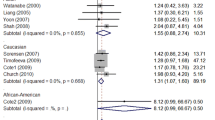Abstract
An imbalance between the phases of biotransformation systems, such as activation, detoxification, and release of toxic substances, is one of the causes of multifactor pathology. Therefore, it is important to examine the impact of the total contribution of the polymorphic variants of xenobiotic-metabolizing enzyme genes at all three phases on predisposition to lung cancer. The purposes of the present work were to study the relationship between polymorphic variants of xenobiotic-metabolizing enzyme genes and risk of lung cancer and to identify molecular genetic markers of predisposition to the disease. It was shown that GSTT1 null-genotype plays a dominant role in the development of lung cancer predisposition in the Belarusian population, while the polymorphic variants of other genes of xenobiotic-metabolizing enzymes render a modifying effect on predisposition to this disease. Combination 734AA CYP1A2/GSTT1(−)/GSTM1(+)/“slow” acetylator has the greatest risk significance, and combination GSTT1(−)/GSTM1(+)/“slow” acetylator exerts a protective effect.
Similar content being viewed by others
References
Polyakov, S.M., Levin, L.F., Shebeko, N.G., and Shcherbina, O.F., Zlokachestvennye novoobrazovaniya v Belarusi 2000–2009 (Malignancies in Belarus in 2000–2009), Sachek, M.M. and Larionov, A.I., Eds., Minsk, 2010.
Nebert, D.W., Ingelman-Sundberg, M., and Daly, A.K., Genetic epidemiology of environmental toxicity and cancer susceptibility: human allelic polymorphisms in drug-metabolizing enzyme genes, their functional importance, and nomenclature issues, Drug Metab. Rev., 1999, vol. 31, no. 2, pp. 467–487.
Goldstraw, P., Crowley, J., Chansky, K., et al., The IASLC lung cancer staging project: proposals for the revision of the TNM stage groupings in the forth-coming (seventh) edition of the TNM classification of malignant tumours, J. Thorac. Oncol., 2007, vol. 2, no. 8, pp. 706–714.
Colby, T.V. and Strickler, J.G., Critical commentary, Pathol. Res. Pract., 1995, vol. 191, no. 11, pp. 1175–1177.
Kotsopoulos, J., Ghadirian, P., El-Sohemy, A., et al., The CYP1A2 genotype modifies the association between coffee consumption and breast cancer risk among BRCA1 mutation carriers, Cancer Epidem. Biomark. Prev., 2007, vol. 16, no. 5, pp. 912–916.
Arand, M., Muhlbauer, R., Hengstler, J., et al., A multiplex polymerase chain reaction protocol for the simultaneous analysis of the glutathione S-transferase GSTM1 and GSTT1 polymorphisms, Anal. Biochem., 1996, vol. 236, no. 1, pp. 184–186.
Gil, J.P. and Lechner, M.C., Increased frequency of wildtype arylamine-N-acetyltransferase allele NAT2*4 homozygotes in Portuguese patients with colorectal cancer, Carcinogenesis, 1998, vol. 19, no. 1, pp. 37–41.
Li, Y., Wang, Y., Sun, J., et al., Distribution of the functional MDR1 C3435T polymorphism in the Han population of China, Swiss Med. Wkly., 1996, vol. 126, nos. 23/24, pp. 377–382.
Rebrova, O.Yu., Comparison of groups on the basis of qualitative binary character, in Statisticheskii analiz meditsinskikh dannykh. Primenenie paketa prikladnykh programm Statistica (Statistical Analysis of Medical Data: Application of the Statistica Software Package), Solovova, M.N, Ed., Moscow: Media Sfera, 2004, Ch. 11, pp. 157–185.
Nowell, S.A., Ahn, J., and Ambrosone, C.B., Genenutrient interactions in cancer etiology, Nutr. Rev., 2004, vol. 62, no. 11, pp. 427–438.
Sachse, C., Brockmoller, J., Bauer, S., et al., Functional significance of a C → A polymorphism in intron 1 of the CYP1A2 gene tested with caffeine, J. Clin. Pharmacol., 1999, vol. 47, no. 4, pp. 445–449.
Hosgood, H.D., Berndt, S.I., and Lan, Q., GST genotypes and lung cancer susceptibility in Asian populations with indoor air pollution exposures: a meta-analysis, Mutat. Res., 2007, vol. 636, nos. 1/3, pp. 134–143.
Raimondi, S., Paracchini, V., Autrup, H., et al., Metaand pooled analysis of GSTT1 and lung cancer: a HuGE-GSEC review, Am. J. Epidemiol., 2006, vol. 164, no. 11, pp. 1027–1042.
Sorensen, M., Autrup, H., Tjonneland, A., et al., Glutathione S-transferase T1 null-genotype is associated with an increased risk of lung cancer, Int. J. Cancer, 2004, vol. 110, no. 2, pp. 219–224.
Spitz, M.R., Duphorne, C.M., Detry, M.A., et al., Dietary intake of isothiocyanates: evidence of a joing effect wit glutathione S-transferase polymorphisms in lung cancer risk, Cancer Epidem. Biomark. Prev., 2000, vol. 9, no. 10, pp. 1017–1020.
Dmitrieva, A.I., The role of polymorphic genes of xenobiotic-metabolizing enzymes and P53 gene in the pathogenesis of cancer, Extended Abstract of Doctoral (Med.) Dissertation, Tomsk, 2009.
Lyakhovich, V.V., Vavilin, V.A., Gavalov, S.M., et al., The role of xenobiotic biotransformation enzymes in the predisposition to asthma and the formation of the features of its clinical phenotype, Vestn. Ross. Akad. Med. Nauk, 2000, no. 12, pp. 36–41.
Muller, D.P., Liu, G., De Vivo, I., et al., Combinations of the variant genotypes of GSTP1, GSTM1 and p53 are associated with an increased lung cancer risk, Cancer Res., 2002, vol. 62, no. 10, pp. 2819–2823.
Borlak, J. and Reamon-Buettner, S.M., N-acetyltransferase 2 (NAT2) gene polymorphisms in colon and lung cancer patients, BMC Med. Genet., 2006, vol. 9, no. 7, p. 58.
Martinez, C., Agundez, J.A., Olivera, M., et al., Lung cancer and mutations at the polymorphic NAT2 gene locus, Pharmacogenetics, 1995, vol. 5, no. 4, pp. 207–214.
Hirvonen, A. Pelin, K., et al., Inherited GSTM1 and NAT2 defects as concurrent risk modifiers in asbestosrelated human malignant mesothelioma, Cancer Res., 1995, vol. 55, no. 14, pp. 2981–2983.
Hou, S.M., Ryberg, D., Falt, S., et al., GSTM1 and NAT 2 polymorphisms in operable and non-operable lung cancer patients, Carcinogenesis, 2000, vol. 21, no. 1, pp. 49–54.
Kroetz, D.L., Pauli-Magnus, C., Hodges, L.M., et al., Sequence diversity and haplotype structure in the human ABCB1 (MDR1, multidrug resistance transporter) gene, Pharmacogenetics, 2003, vol. 13, no. 8, pp. 481–494.
Author information
Authors and Affiliations
Corresponding author
Additional information
Original Russian Text © A.P. Mikhalenko, E.V. Krupnova, N.N. Chakova, N.V. Chebotareva, Yu.E. Demidchik, 2014, published in Tsitologiya i Genetika, 2014, Vol. 48, No. 2, pp. 52–59.
About this article
Cite this article
Mikhalenko, A.P., Krupnova, E.V., Chakova, N.N. et al. Assessment of the relationship between combinations of polymorphic variants of xenobiotic-metabolizing enzyme genes and predisposition to lung cancer. Cytol. Genet. 48, 111–116 (2014). https://doi.org/10.3103/S009545271402008X
Received:
Published:
Issue Date:
DOI: https://doi.org/10.3103/S009545271402008X




